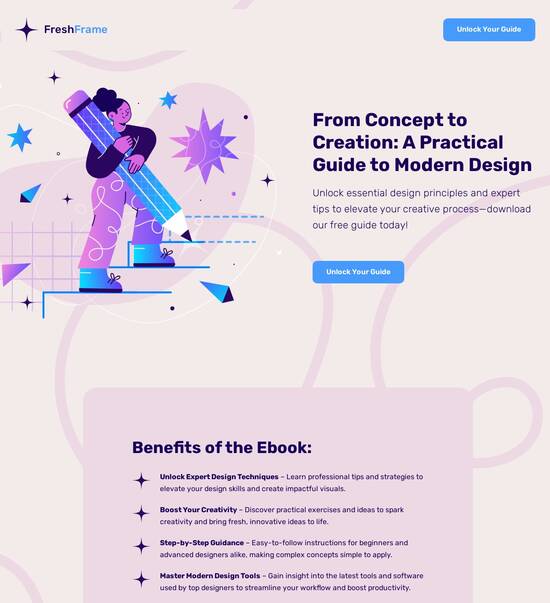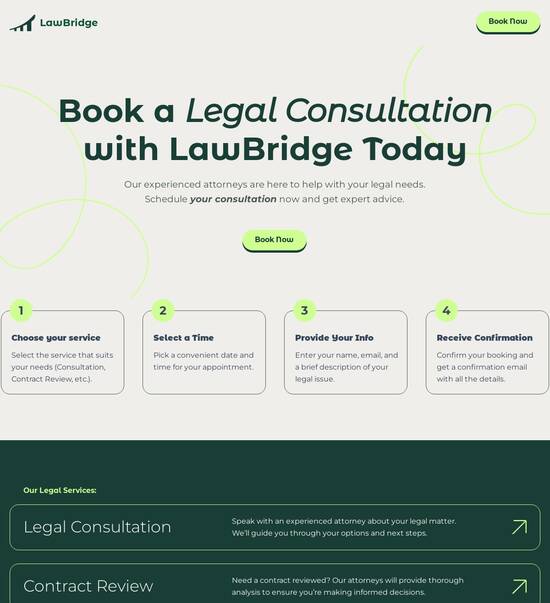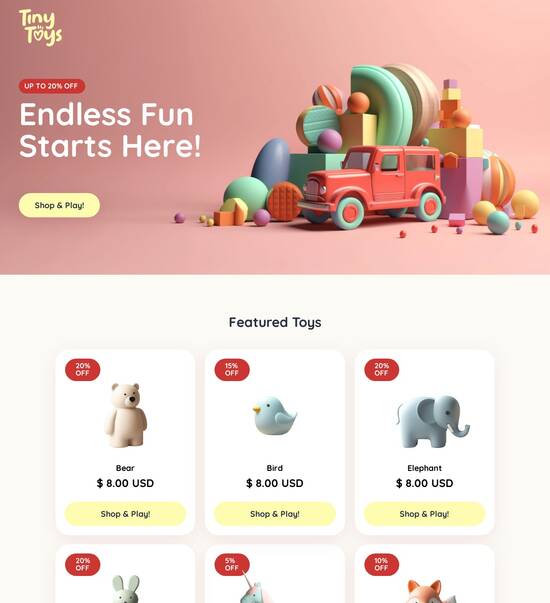
PHP optimized disclaimer page template
Explore Similar TemplatesAbout template
Supercharge your disclaimer page with PHP for outstanding performance! Learn more today.
Recommended templates

Easy to build without coding
With the intuitive drag-and-drop builder, anyone on your team can create high-converting pages without any knowledge of code or design. Make enhancements to your landing page with custom widgets using Javascript, HTML/CSS, or third-party scripts.

Multiple layouts for any industry and goal
Select from 500+ landing page layouts built to boost conversions across industry-specific scenarios. Customize them by adjusting fonts, adding images, and generating on-brand content with the AI assistant. Quickly scale with Instablocks® and Global Blocks that you can save, reuse, and update globally.

Loads fast and looks polished on any device
Every template is responsive, which means they present professionally on any device and load blazingly fast with our Thor Render Engine. You can also power them up with Google AMP technology to deliver an unparalleled mobile experience and drive higher conversions.

Robust analytics & experimentation
Get real-time updates and reporting across all your devices, showing the number of visitors, conversions, cost-per-visitor, and cost-per-lead. Launch AI-powered experiments, run A/B tests, and use heatmaps to analyze user behavior, then optimize your landing page to maximize conversions.







Easy to build without coding
With the intuitive drag-and-drop builder, anyone on your team can create high-converting pages without any knowledge of code or design. Make enhancements to your landing page with custom widgets using Javascript, HTML/CSS, or third-party scripts.
Multiple layouts for any industry and goal
Select from 500+ landing page layouts built to boost conversions across industry-specific scenarios. Customize them by adjusting fonts, adding images, and generating on-brand content with the AI assistant. Quickly scale with Instablocks® and Global Blocks that you can save, reuse, and update globally.
Loads fast and looks polished on any device
Every template is responsive, which means they present professionally on any device and load blazingly fast with our Thor Render Engine.
Robust analytics & experimentation
Get real-time updates and reporting across all your devices, showing the number of visitors, conversions, cost-per-visitor, and cost-per-lead. Launch AI-powered experiments, run A/B tests, and use heatmaps to analyze user behavior, then optimize your landing page to maximize conversions.
All the features you need to build lead-generating landing pages
Explore more featuresLearn how to build top-performing landing pages for any goal
FAQs
Leading the way in building high-performing landing pages





An effective guide for using Instapage for landing page optimization
Maximizing ROI from your digital marketing campaigns is crucial in today's competitive landscape. Instapage provides a powerful landing page and conversion rate optimization (CRO) platform that enhances your marketing efforts, ensures quick deployment, and boosts lead generation. This guide will walk you through the essential steps to utilize Instapage effectively, ensuring every aspect aligns with your campaign goals.
Step 1: Selecting the right templates
Choosing the right templates is vital for effective landing page creation. Instapage offers a library of over 100 high-converting templates designed specifically for various industries such as education, tech/SaaS, and financial services. These templates ensure that you can hit the ground running without any coding expertise.
- Customization: Each template can be tailored to match your branding and messaging.
- Responsive design: All templates automatically adjust for mobile and tablet displays, ensuring a seamless user experience.
- Lead generation elements: Pre-built forms and call-to-action buttons are included to streamline lead capture.
Step 2: Optimize for conversions
Once your templates are selected, optimizing them for conversions is the next step. Instapage includes built-in A/B testing and detailed heatmaps that help you track user behavior on your pages.
- A/B Testing: Run multiple versions of your landing pages to find the best-performing elements, such as headlines and images.
- Heatmaps: Gain insights into user engagement by visualizing where users are clicking and scrolling.
- Analytics dashboard: Access detailed performance metrics to analyze the effectiveness of your landing pages.
Step 3: Personalization for targeted audiences
Personalizing user experiences can significantly improve conversion rates. Utilize features like dynamic text replacement and AdMaps to align your ads to the specific pages that resonate with your unique audiences.
- Dynamic text replacement: Automatically change text on your landing pages based on the user's ad to enhance relevance.
- AdMap functionality: Visually map your ad campaigns to the corresponding landing pages to ensure cohesive messaging.
- Audience-level tracking: Monitor and analyze how different audience segments are interacting with your content.
In conclusion, leveraging the features of Instapage not only streamlines your landing page creation but also enhances your digital marketing strategies. With its user-friendly interface, powerful analytics, and collaborative tools, you have everything you need to maximize your marketing effectiveness.
Ready to transform your marketing campaigns? Start using Instapage today and unlock the full potential of your digital marketing strategies.
PHP optimized disclaimer page template: Importance and implementation
Understanding the importance of a disclaimer page in web development
A disclaimer page acts as a shield for businesses, educating users about the limitations of liability and stipulating the conditions of engaging with the content on a website. This document is not merely a formality; it holds significant weight in legal contexts. Hence, it is crucial for website owners to grasp the intricacies surrounding disclaimers to safeguard themselves effectively.
Legal protection for businesses: A well-crafted disclaimer can protect against potential lawsuits arising from misunderstandings or misinterpretations of content.
Establishing transparency with users: Disclaimers clarify expectations, promoting a trustworthy relationship between the site and its visitors.
Differentiating types of disclaimers: Familiarity with various disclaimers, such as affiliate, medical, and general disclaimers, ensures appropriate coverage tailored to specific content.
Understanding the nuances of disclaimer pages is particularly vital for freelancers and small business owners who may have greater exposure to liability issues and less institutional support.
Why disclaimers matter for freelancers and small businesses
For freelancers and small businesses, disclaimers not only offer protection against liability but can also foster trust among visitors. When potential clients see clearly marked disclaimers, they perceive the business as more professional and transparent. This builds confidence in their offerings, helping to convert casual visitors into loyal customers.
Protecting against liability: Having a strong disclaimer can save both time and money by potentially preventing legal disputes.
Enhancing trust with visitors: Transparency about content accuracy and affiliate relationships helps establish user confidence.
Compliance with industry standards: Certain industries have specific legal requirements regarding disclaimers, making adherence crucial.
In sectors such as finance or health, where misinformation can lead to severe consequences, having a disclaimer becomes not just standard practice but a necessity for safeguarding both the business and its clients.
Crafting an optimized disclaimer page template
Creating a disclaimer page template requires an understanding of essential components that must be both informative and user-friendly. The template should encompass specific elements that provide clarity and legal coverage while remaining approachable for the reader.
Clear definitions and terms: Ensuring that terminology is well-defined aids users' comprehension and respect for the content.
Scope of liability: This should outline the limitations of the website's responsibilities, particularly regarding external links and third-party content.
Links to privacy and terms of service pages: Providing easy access to related documents ensures users have comprehensive information.
User-friendly language is also essential. Avoiding legal jargon helps visitors understand their rights and the business's obligations better. Furthermore, the layout and design play critical roles; effective use of whitespace and logical organization enhances readability.
PHP as a dynamic solution for disclaimer pages
PHP stands out as a powerful tool for creating dynamic content that can optimize your disclaimer pages. By leveraging PHP, developers can create templates that are easily adjustable and scalable, making it easier to comply with evolving legal requirements while maintaining a robust online presence.
Easy updates and scalability: PHP allows for simple modifications to content as regulations change without an overhaul of the entire framework.
Custom templates based on user engagement: PHP can analyze user behavior, enabling tailored content that meets specific audience needs.
Integrating PHP with modern HTML5 and Bootstrap frameworks can enhance the appearance and performance of your disclaimer page, ensuring that it is responsive and accessible across devices. This seamless collaboration is crucial for delivering a consistent user experience, regardless of device type.
Features of a PHP optimized disclaimer page template
Emphasizing responsive design enhances usability and user experience. Using Bootstrap for your disclaimer template can significantly impact how users interact with the page, ensuring it looks appealing and functions well on a variety of devices. The advantages offered by Bootstrap 3 include a grid system that simplifies layout adjustments, pre-styled components that save time, and a focus on mobile-first design.
Overview of Bootstrap 3 benefits: Faster development time and consistent design are key advantages when utilizing Bootstrap.
How responsive design influences user behavior: A fluid layout enhances user retention by reducing bounce rates and encouraging deeper engagement with content.
Examples of well-structured Bootstrap admin templates: Several pre-designed templates can streamline the process of creating tailored disclaimer pages.
By adopting a user-friendly responsive design, you cater to a wider audience, making it easier for mobile users to navigate. Well-structured templates lead to a more professional appearance that can significantly impact visitor trust and site credibility.
HTML admin templates for enhanced usability
Incorporating HTML admin templates can further improve the usability of your disclaimer page. These templates often come equipped with user management features and customization options tailored to various business types. By allowing easy modifications, HTML templates cater to the specific needs of different audiences.
Integration of user management features: Facilitating user access and content management allows for streamlined updates without needing extensive coding knowledge.
Customization options for different website types: Having diverse designs enables businesses to align their disclaimers with their branding.
Comparison with traditional HTML: The benefits of HTML5 templates include better semantic structure, improved accessibility, and enhanced performance over older versions.
Emphasizing the importance of HTML templates highlights how they are not just a matter of aesthetics but also significantly affect functionality and user experience. High-quality templates enable a blend of practicality and appealing design on your site.
Multipurpose SaaS & startup themes
For startups and small businesses, choosing multipurpose templates is often a smart move. These templates are designed with flexibility in mind, accommodating a range of business models and industries. By selecting a robust template, these organizations can save time on design while benefiting from a professional, consistent appearance.
Why multipurpose templates are optimal for various industries: These templates minimize the need for extensive customization, making them a cost-effective solution for startups.
Case studies of successful startups using optimized templates: These examples demonstrate how effective design can contribute to brand growth and user engagement.
Trendy design considerations for engagement and retention: Staying current with design trends can enhance the appearance and functionality of the disclaimer.
Focusing on a cohesive and appealing design while ensuring it aligns with user expectations can lead to better retention rates and user satisfaction.
Practical implementation of your disclaimer page
Setting up a PHP disclaimer page doesn't have to be complicated. This process can be streamlined through practical steps that allow for efficient implementation while ensuring compliance with legal standards.
Selecting and customizing a Bootstrap admin template: Start with a responsive template and tailor it to your branding needs.
Creating a PHP file for the disclaimer page: Set up a dedicated PHP file to manage the content dynamically.
Adding dynamic elements to enhance user experience: Utilize PHP to make the content appealing and engaging.
Implementing best practices for SEO on disclaimer pages: Optimize content and metadata to improve search visibility.
By focusing on these steps, businesses can efficiently launch a disclaimer page that effectively serves its purpose while also enhancing overall site performance.
User testing and feedback
Once the disclaimer page is set up, gathering user feedback becomes vital. This will ensure that the content resonates with visitors, and the design remains functional and accessible. Testing user interactions and adjusting based on empirical data can significantly improve efficiency.
Importance of gathering feedback from visitors: Understanding user perspectives provides critical insights for improving the disclaimer.
Utilizing A/B testing to refine content layout and messages: Test different versions of the disclaimer to determine which is most effective.
Tools for monitoring user interactions and bounce rates: Utilizing analytics tools supports ongoing improvements.
Regularly evaluating user feedback can help to keep the disclaimer page relevant and user-friendly, further enhancing its effectiveness.
The role of design in optimizing disclaimer pages
Design plays a crucial role in how users experience a disclaimer page. The visual hierarchy guides visitors through the content seamlessly, which is essential for retaining their attention and ensuring they comprehend the information presented.
How design elements guide user behavior: Strategic placement of content can influence navigation patterns.
Effective use of whitespace and typography: These factors significantly impact readability and engagement.
Case study: before and after design overhaul for a disclaimer page: Highlighting successful redesigns illustrates the impact of good design.
Adhering to industry standards in design not only boosts aesthetics but also ensures legal compliance, giving visitors the confidence they need to engage with your site.
Industry standards for compliance and aesthetics
Maintaining compliance with industry standards is essential for building credibility in the digital space. Certain disclaimers must meet regional laws, and ensuring the design complies with accessibility standards maximizes user engagement.
Overview of common compliance requirements: Businesses need to adhere to legal regulations informative disclaimers.
Best practices for keeping designs up-to-date: Regularly revisiting design elements helps maintain relevance.
Examples of templates adhering to legal guidelines: Providing real-world examples demonstrates effective compliance.
By keeping designs updated and ensuring adherence to legal guidelines, businesses can present themselves as trustworthy and responsible while minimizing potential pitfalls.
Elevating user experience with advanced features
Incorporating advanced features into the disclaimer page can make the experience more engaging for users. Adding interactive elements such as FAQs or pop-up tooltips can clarify common queries, enhancing understanding and improving navigation.
Benefits of adding FAQs or pop-up tooltips: Users often seek quick answers; these features can efficiently meet that need.
How interactive content can reduce confusion among visitors: Engaging users through interactivity can lower bounce rates.
Examples of well-designed interactive disclaimers: Showcasing specific cases where interactivity improved user experience.
Incorporating interaction caters to a better user experience overall, resulting in higher satisfaction and retention rates.
Integrating with apps for enhanced functionality
Linking the disclaimer page with various web applications can create a more cohesive user experience. Integration drives functionality while ensuring users have all relevant information in one location.
Ways to link the disclaimer page with website apps: From subscription services to customer service tools, integration enhances usability.
Leveraging API connections for real-time updates: APIs can ensure that all dynamic content reflects the most current information.
Ensuring a seamless experience across all platforms: Consistency across touchpoints increases user trust and satisfaction.
By maximizing integration, organizations can simplify the user journey, enabling visitors to access crucial information quickly and efficiently.
Maintaining your disclaimer page for long-term effectiveness
A disclaimer page is not a one-time setup; it requires continual maintenance. As businesses evolve and legal landscapes change, it’s vital to regularly review and update disclaimers to remain compliant and relevant.
How frequently should disclaimers be revised?: A good practice is to revisit disclaimers at least annually or whenever there are significant organizational changes.
Establishing a review cycle based on industry changes: Keeping abreast of sector specifics promotes proactive compliance.
Importance of keeping legal advice readily available: Ensuring access to legal expertise helps mitigate risks.
By integrating these maintenance practices, businesses reinforce the credibility of their disclaimer and protect themselves in the long run.
Monitoring performance metrics
In addition to keeping the disclaimer content updated, assessing performance metrics is essential for understanding its effectiveness. Monitoring how users interact with the disclaimer allows for data-driven improvements.
Key metrics to evaluate the effectiveness of your disclaimer page: Bounce rates, time spent on page, and user feedback are all critical indicators.
Tools for analyzing user engagement and page success: Analytics platforms offer valuable insights into user behavior.
Adapting templates based on data-driven insights: Use monitored data to make informed changes to the disclaimers.
Establishing a performance monitoring system around the disclaimer ensures it serves its intended role effectively while adapting to user needs.
Conclusion: Embracing innovative templates for future-ready disclaimers
Disclaimer pages are essential components of any website, and optimizing them with modern templates is key to achieving legal compliance and user satisfaction. With ongoing changes in the digital environment and legal standards, it is vital for marketers to stay informed about impending trends in web design and legal compliance.
Anticipated trends in web design and legal compliance: Continuous development in UX and usability further drives demand for adaptable templates.
Embracing new technologies and coding practices: Integrating evolving technologies contributes to more robust designs.
The ongoing necessity of adaptable, user-centric designs: Focus on user experience fosters a positive interaction with the business.
By evolving disclaimer pages alongside advancements in technology and user expectations, businesses can create spaces that not only inform users but also compel them to engage thoughtfully.
Ready to skyrocket conversions?
Supercharge your ad campaigns with high-performing landing pages
Get started














